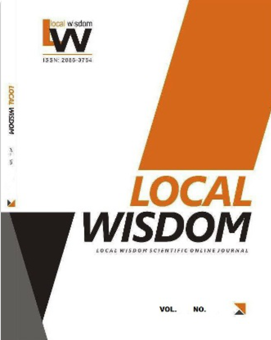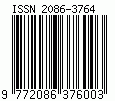How the Communal Buildings Created? Socio-Spatial Transformation of the Osing in Kemiren Village towards Social Sustainability
DOI:
https://doi.org/10.26905/lw.v13i2.5184Keywords:
Communal building, Socio-spatial transformation, Social Sustainability, the Osing, Traditional HousesAbstract
The socio-cultural life of the Osing in Kemiren Village always interplays with their social activities and interactions, both among local people and travelers who come to visit the village. To accommodate these various activities, the Osing uses communal buildings, such as the Pesantogan Kemangi and two cultural houses: the Sukosari and the Osing. Data from the field reveals that the traditional house is a reference for creating communal buildings. The study aims to disclose the transformation process in spatial patterns and forms that occurs in communal facilities. It discusses a set of combination parts of traditional houses that create communal buildings. A qualitative inquiry was carried out the study with the ethnography approach. The result shows that socio-spatial transformation occurs in a dynamic change of communal activities that affect new architectural models of the public buildings. The transformation includes dimensional spatial patterns and building shapes, reduction, and additional spaces and components. Finally, the study contributes to being a reference for future research in the traditional architecture of the Osing. Both the local government and people work organized in preserving traditional architectural values as a pearl of local wisdom. Therefore, it supports and encourages tourism programs in Kemiren Village towards a socially sustainable community.
Downloads
References
Bacon, E. (1974) Design of the City, Revised Edition, Viking, New York.
Carmona M., Magalhaes S., Hammond L. (2008) Public Space, the Management Dimension, Routledge, Taylor and Francis Group, London and New York,
Cassiers, T. and Kesteloot, C. (2012) “Socio-spatial Inequalities and Social Cohesion in European Cities†Urban Studies, 49(9), 1909–1924.
Creswell, J.W. (2007) Qualitative Inquiry and Research Design: Choosing among Five Approaches, Second Edition, SAGE Publications, Los Angeles.
Creswell, J.W. (2009) Research Design. Qualitative, Quantitative, and Mixed Methods Approaches. SAGE Publications, Los Angeles.
Darmiwati, R. (2000) “Studi Ruang Bersama dalam Rumah Susun bagi Penghuni Berpenghasilan Rendah†DIMENSI (Jurnal Teknik Arsitektur), 28(2), Institute of Research and Community Outreach - Petra Christian University, Surabaya.
Debby, T.R. and Dewi, S.P. (2019) “Transformasi Sosio-Spasial Kawasan Pecinan Kota Semarang†Pengembangan Kota, 7(1), 46-56.
Dewi, Z.L. and Yuliastuti, N. (2015) “Pemanfaatan Ruang Bersama di Rusunawa Kaligawe, Semarang†Jurnal RUANG, 1(4), 181-190.
Febrianto, et al. (2017) “Pola Spasial Teritori pada Lanskap-Hunian Masyarakat Peladang Desa Juruan Laok Madura Timur†Jurnal Arsitektur ARTEKS, 2(1), 59-74.
Fitria, T.A. (2018) “Keterkaitan Perilaku Pengguna dengan Pola Ruang Kawasan†Arsitektur dan Perencanaan, 1(1), 97-105.
Giddens, A. (1990) The Consequences of Modernity, Polity Press, Cambridge.
Harpioza, O.D. (2016) “Identifikasi Perubahan Arsitektur Rumah Tradisional Studi Kasus Permukiman Desa Kurau, Aliran Sungai Desa Kurau di Kabupaten Bangka Tengah, Provinsi Bangka Belitung†Laporan Tesis. Universitas Atma Jaya, Yogyakarta.
James, P. (2015) Urban Sustainability in Theory and Practice: Circles of sustainability, Routledge, New York.
Madanipour, A. (2005) Public and Private Spaces of the City, Routledge, London.
Musyaffa, H. (2010) “Seting Ruang Komunal dalam Rumah Kos†Laporan Skripsi. Universitas Indonesia, Depok.
Parkinson, J. (2012) Democracy and Public Space, Oxford University Press, Oxford.
Pattison, P. and Robins, G. (2004) “Building Models for Social Space: Neighbourhood-Based Models for Social Networks and Affiliation Structures†Mathematics and Social Sciences, 42(168), 11-29.
Purwanto, E. (2007) “Rukun Kota–Kota Berbasis Budaya Guyub†Laporan Disertasi, Universitas Gajah Mada, Yogyakarta.
Shaftoe, H. (2012) Convivial Urban Spaces: Creating Effective Public Places, Earthscan, London.
Suprijanto, I. (2002) “Rumah Tradisional Osing: Konsep Ruang Dan Bentuk†Jurnal Dimensi Teknik Arsitektur, 30(1), 10-20.
Tamariska, S.R. and Ekomadyo, A. (2016) “Place-making’ Wadah Interaksi Sosial Kampung Kota†Prosiding Seminar Nasional Kearifan Lokal, Dept Arsitektur USU, Medan.
Tamariska, S.T. et al. (2017) “Peran Ruang Komunal terhadap Keberlanjutan Sosial: Studi Komparasi Perumahan Terencana dan Perumahan Tidak Terencana (Perumahan Sukaluyu Dan Kampung Tubagus Ismail Bawah)†Prosiding Seminar Nasional Kearifan Lokal dalam Keberagaman untuk Pembangunan Indonesia, 285-292, Departemen Arsitektur, Fakultas Teknik, Universitas Sumatera Utara, Medan.
Walgito, B. (2003) Pengantar Psikologi Umum, Andi Offset, Yogyakarta.
Widiyastuti, D. (2013) “Transformation of Public Space: Social and Spatial Changes A Case Study of Yogyakarta Special Province, Indonesia†Doctoral Dissertation, University of Dortmund (TU Dortmund), Dortmund Germany.
Yiftachel, O and Hedgcock, D. (1993) “Urban Social Sustainability: the Planning of an Australian City†Cities, 10, 139-157.
Yin, R.K. (2014) Case Study Research: Design and Methods, Fifth Edition. SAGE Publications, Los Angeles












